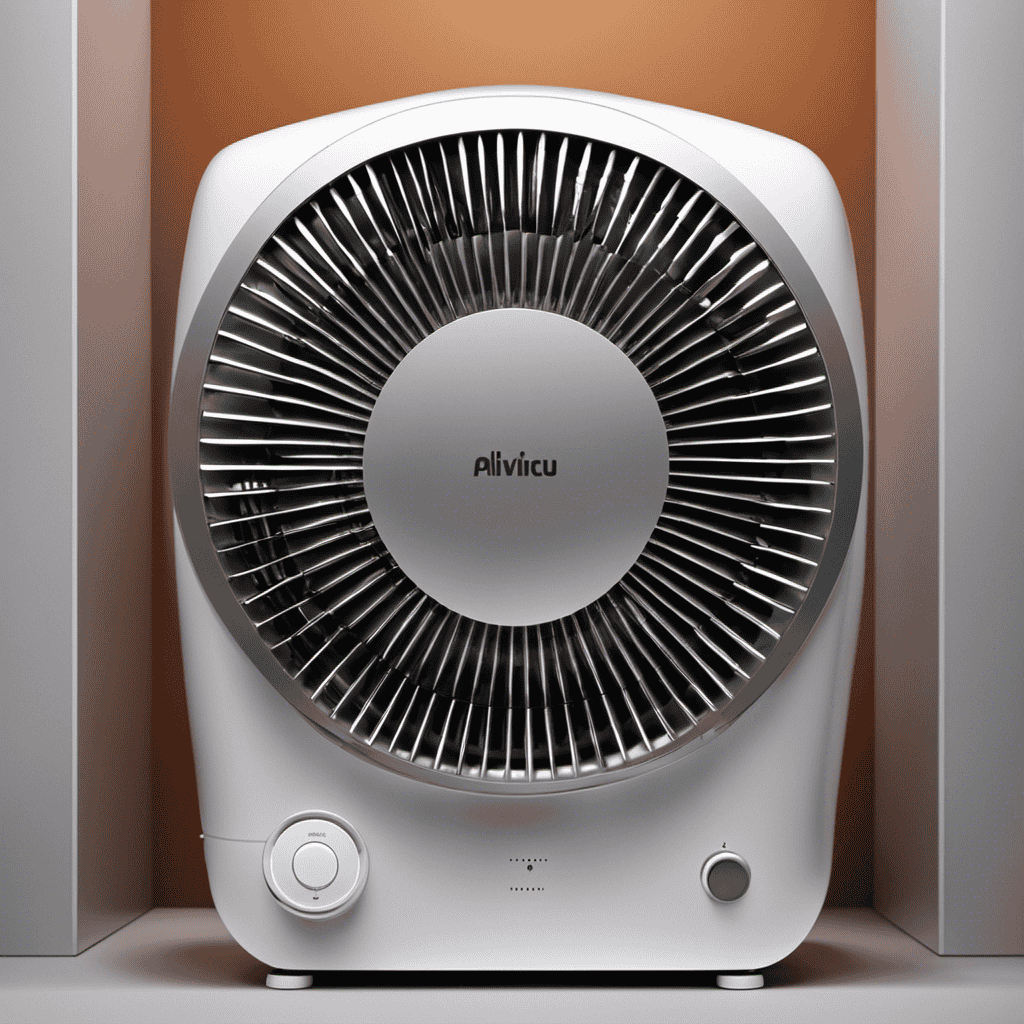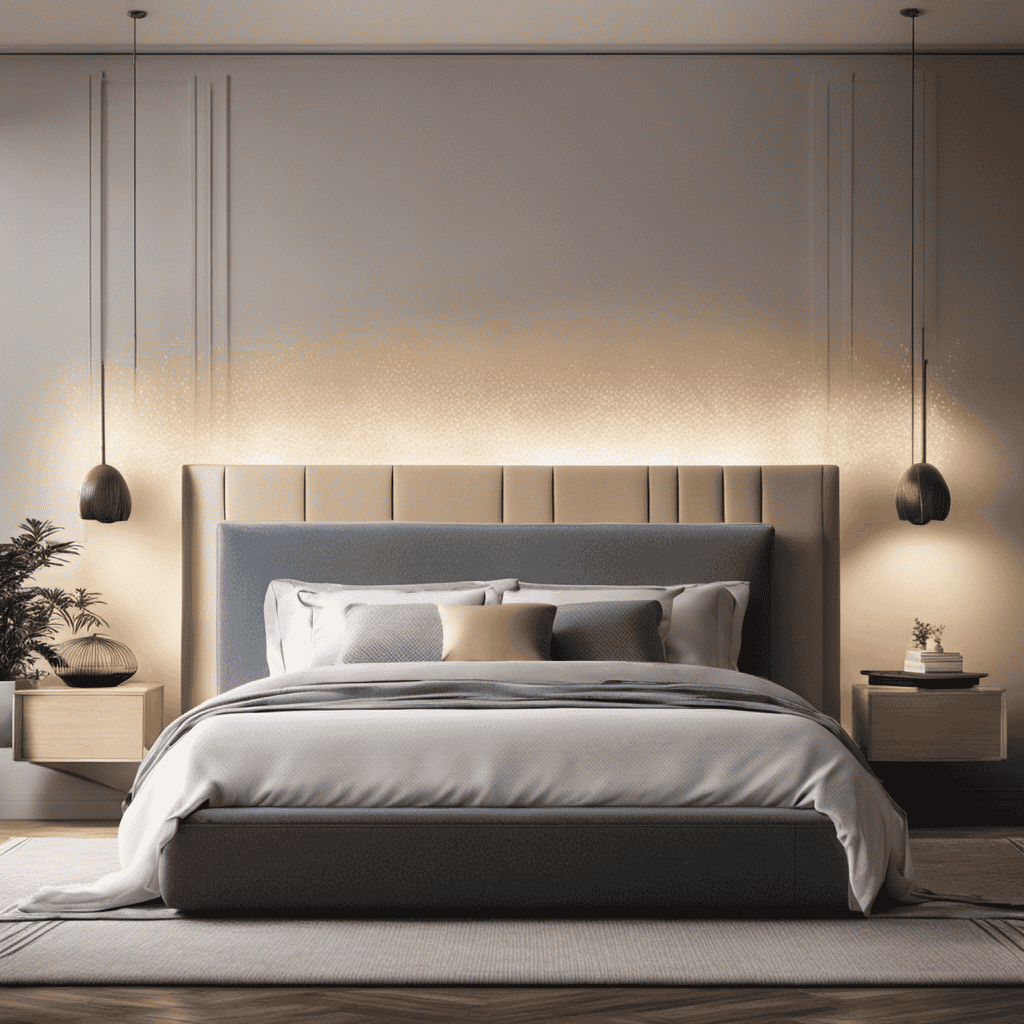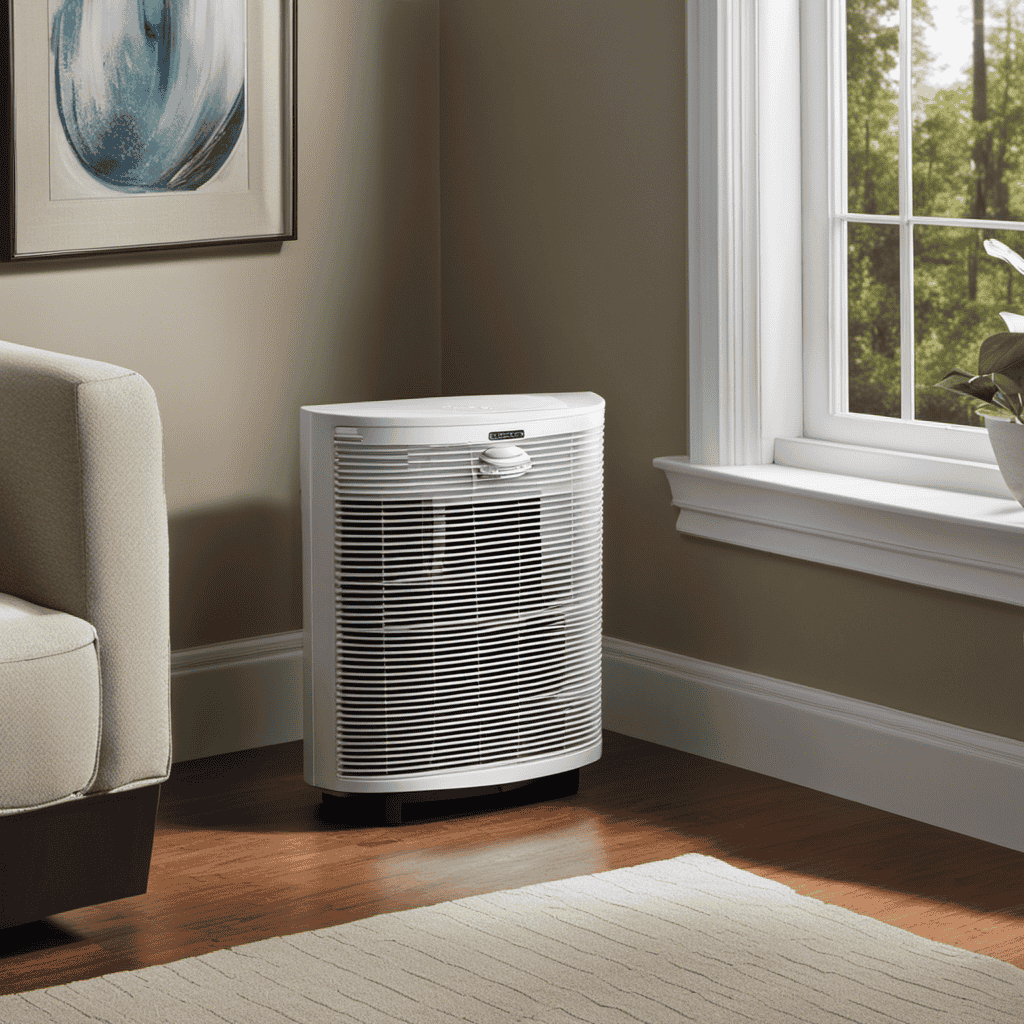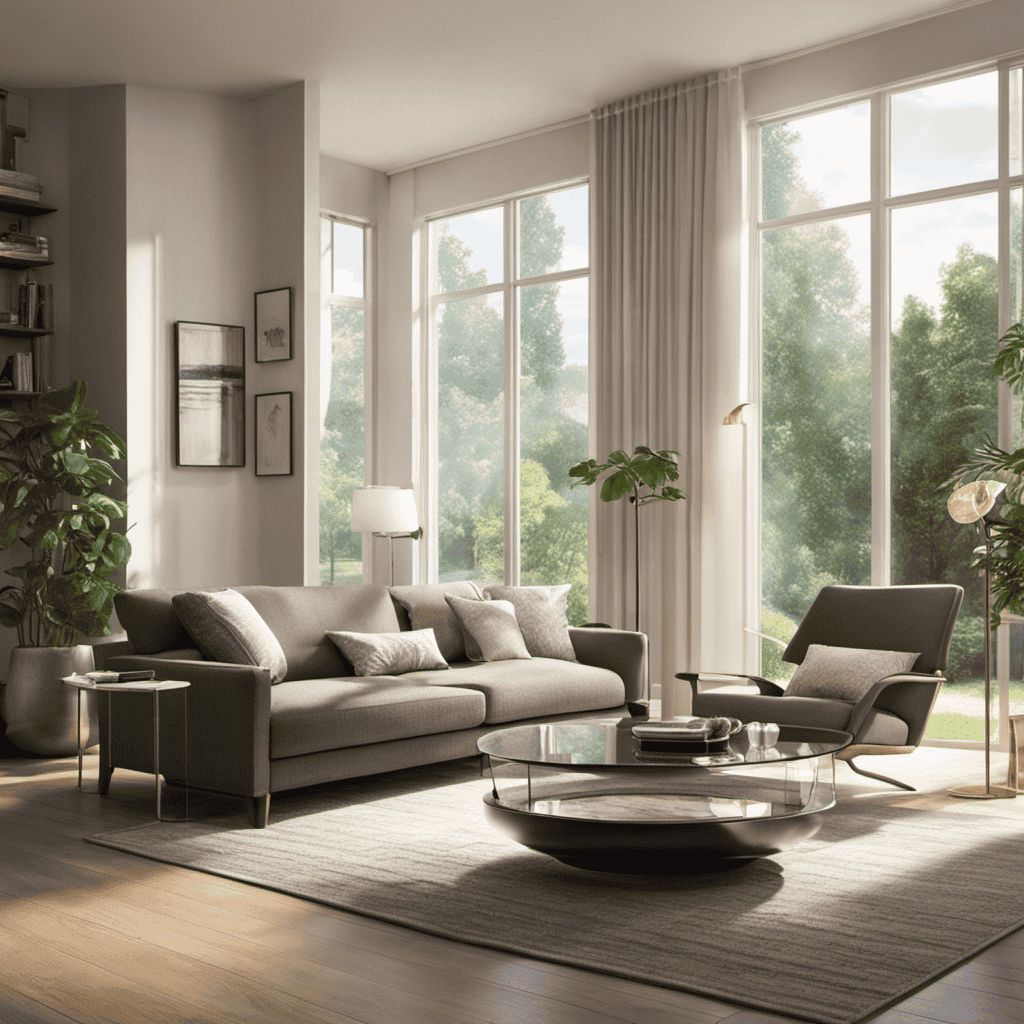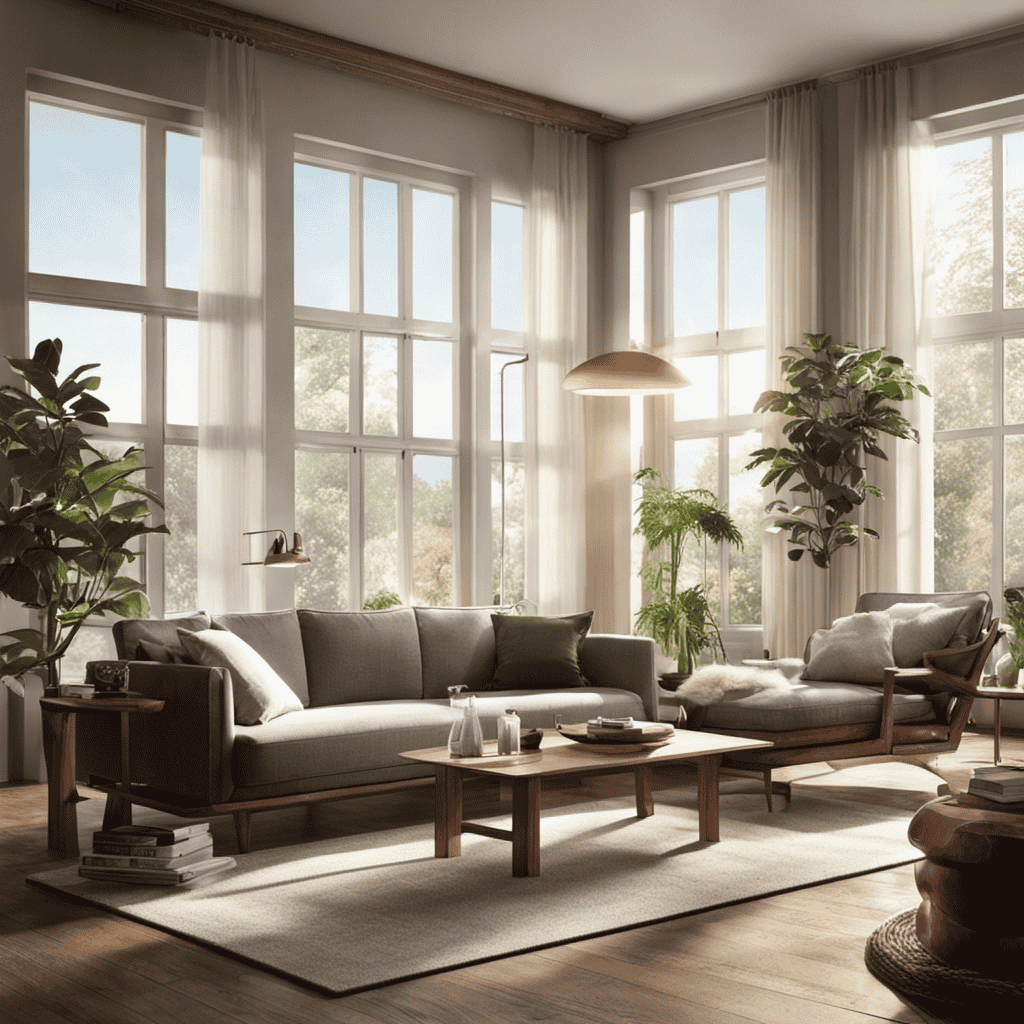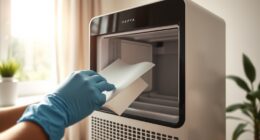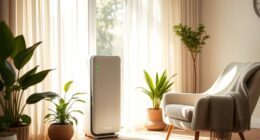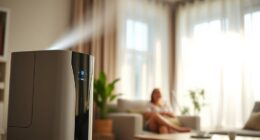Hello, everyone!
Ever wondered how those nifty air purifiers actually work their magic? Well, buckle up and get ready for a fascinating journey into the world of air purification.
In this article, I’ll be taking you through the ins and outs of how air purifiers operate, using an animation to bring it all to life. From the basics of air purification to the role of different filters and technologies, we’ll cover it all.
So, let’s dive in and demystify the inner workings of these air-cleaning wonders!
Key Takeaways
- Air purifiers remove contaminants from the air, improving air quality.
- The air purification process involves pre-filters, activated carbon filters, HEPA filters, and ionizers or UV-C light.
- Activated carbon filters play a crucial role in eliminating odors and trapping harmful VOCs.
- UV-C light technology is effective in neutralizing bacteria, viruses, and mold spores, but proper use and maintenance are important.
The Basics of Air Purifiers
If you’re wondering how air purifiers work, it’s important to understand the basics.
Air purifiers are devices that are designed to remove contaminants from the air, improving the overall air quality in a room or space. They offer numerous benefits, such as reducing allergens, eliminating odors, and removing harmful pollutants.
Air purifiers have various features that contribute to their effectiveness. One key feature is the use of filters, which trap particles and pollutants as air passes through. Some air purifiers also use UV-C light technology to kill bacteria and viruses. Additionally, many models have adjustable fan speeds and timers, allowing for customized operation.
Understanding the air purification process is crucial to fully comprehend how air purifiers work and the benefits they provide.
Understanding the Air Purification Process
To understand how the air purification process works, you’ll need to know about the different stages involved.
Indoor air quality is of utmost importance, as it directly affects our health and well-being. Using an air purifier can greatly improve the quality of the air we breathe, leading to a host of benefits.
The first stage in the air purification process is the pre-filter, which captures larger particles like dust and pet dander.
Next, the activated carbon filter absorbs odors and gases.
Then, the HEPA filter traps smaller particles, such as pollen and mold spores.
Finally, the air is passed through an ionizer or UV-C light to further neutralize any remaining contaminants.
Types of Air Filters Used in Purifiers
When it comes to air purification, understanding the particle removal efficiency, filter replacement frequency, and different filter technologies is crucial.
Particle removal efficiency refers to the ability of an air filter to capture and remove airborne particles of various sizes.
Knowing the filter replacement frequency is important as it ensures optimal filtration performance and prevents the buildup of contaminants in the air.
Additionally, exploring different filter technologies allows us to compare their effectiveness in removing pollutants and choose the most suitable option for our specific needs.
Particle Removal Efficiency
You’ll notice that the particle removal efficiency of the air purifier is significantly higher than other models. To understand this, let’s look at the efficiency testing and particle size distribution. Efficiency testing measures how well the purifier can remove particles of different sizes from the air. The particle size distribution refers to the range of particle sizes present in the air. The table below shows the particle removal efficiency of our air purifier compared to other models:
| Particle Size (microns) | Our Air Purifier (%) | Other Models (%) |
|---|---|---|
| 0.3 | 99.9 | 95.5 |
| 1.0 | 99.8 | 93.2 |
| 2.5 | 99.5 | 89.7 |
| 10.0 | 99.0 | 82.3 |
As you can see, our air purifier consistently outperforms other models in removing particles of various sizes. This high efficiency ensures cleaner and healthier air in your surroundings. Now, let’s move on to the next section, where we will discuss the importance of filter replacement frequency.
Filter Replacement Frequency
Maintaining a regular schedule for filter replacement is essential to ensure the optimal performance of your air purifier.
Indoor air quality is a critical factor in maintaining a healthy living environment. Air purifiers play a significant role in improving indoor air quality by removing harmful pollutants and allergens.
However, over time, the filters in air purifiers become clogged with these particles, reducing their efficiency. Regularly replacing the filters is crucial to maintain the desired level of air purification.
By doing so, you can ensure that your air purifier continues to provide clean and fresh air, free from dust, pollen, pet dander, and other airborne contaminants. This not only benefits your respiratory health but also enhances overall well-being.
Different Filter Technologies
To understand the different filter technologies, it’s important to research and compare the options available in the market. When it comes to filter effectiveness comparison, there are various factors to consider.
High-efficiency particulate air (HEPA) filters are widely recognized for their ability to remove 99.97% of particles as small as 0.3 microns. These filters are highly effective in capturing allergens, dust, pollen, and pet dander, thus significantly improving air quality.
Another option is activated carbon filters, which excel at removing odors, chemicals, and volatile organic compounds (VOCs). Additionally, electrostatic filters use an electric charge to attract and capture particles.
Each filter technology has its own advantages and limitations, so it’s essential to choose one that suits your specific needs. Understanding these different filter technologies is important for comprehending how air purifiers remove particulate matter and improve indoor air quality.
How Air Purifiers Remove Particulate Matter
When using an air purifier, it’s important to understand how it removes particulate matter from the air. Air purifiers work by using different filter technologies to trap and remove pollutants from the air. One of the most common types of filters used in air purifiers is a High-Efficiency Particulate Air (HEPA) filter. HEPA filters are designed to capture particles as small as 0.3 microns, including dust, pollen, and pet dander. Another type of filter often used in air purifiers is an activated carbon filter, which is effective at removing odors and chemicals from the air. Some air purifiers also use ionizers or electrostatic precipitators to charge particles, causing them to stick to surfaces or be collected in a separate filter.
To give you a better idea of how air purifiers remove particulate matter, here is a table that summarizes the different filter technologies and their benefits:
| Filter Technology | Benefits |
|---|---|
| HEPA Filter | – High efficiency in capturing small particles |
| – Removes dust, pollen, and pet dander | |
| Activated Carbon Filter | – Removes odors and chemicals from the air |
| – Absorbs gases and VOCs | |
| Ionizers/Electrostatic Precipitators | – Charges particles, causing them to stick to surfaces |
| – Removes airborne particles |
When purchasing an air purifier, there are several factors to consider. First, consider the size of the room where the air purifier will be used. Different air purifiers have different coverage areas, so make sure to choose one that is suitable for the size of your room. Additionally, pay attention to the Clean Air Delivery Rate (CADR), which indicates how effectively an air purifier can remove pollutants from the air. Finally, consider the noise level and energy consumption of the air purifier, as these factors can affect your overall satisfaction with the device.
The Role of Activated Carbon in Air Purification
When it comes to air purification, activated carbon plays a crucial role. It is responsible for eliminating odors and removing harmful volatile organic compounds (VOCs). Carbon filters are specifically designed to trap and absorb odorous molecules, preventing them from circulating in the air.
Additionally, these filters have the ability to capture VOCs. VOCs are known to have adverse effects on human health. Therefore, by using activated carbon filters, air purifiers can effectively remove both odors and harmful compounds, ensuring cleaner and healthier air for everyone.
Carbon Filters Trap Odors
Carbon filters in air purifiers trap odors, keeping the air in your home fresh and clean. Odor elimination is an important aspect of air freshening, as unpleasant smells can make the indoor environment uncomfortable.
Carbon filters are designed to capture and neutralize a wide range of odorous compounds. The activated carbon used in these filters has a porous structure that allows it to adsorb and trap odor molecules. As the air passes through the filter, the carbon attracts and holds onto the odor-causing particles, effectively removing them from the air.
This process, known as adsorption, helps to eliminate odors and improve indoor air quality. By using carbon filters in air purifiers, you can enjoy a more pleasant and odor-free environment in your home.
Removes Harmful Vocs
To remove harmful VOCs from your indoor air, consider using an air purifier with activated carbon filters. These filters are designed to capture and trap volatile organic compounds (VOCs), which are harmful chemicals often found in household products, building materials, and furniture.
Here are three reasons why using an air purifier with activated carbon filters can improve your air quality:
-
Adsorption: Activated carbon has a highly porous structure that allows it to effectively adsorb VOCs. As air passes through the filter, the carbon attracts and holds onto the harmful chemicals, preventing them from recirculating back into the room.
-
Chemical Decomposition: In addition to adsorption, activated carbon filters also promote chemical decomposition of VOCs. The carbon’s surface contains active sites that can react with the chemicals, breaking them down into less harmful substances.
-
Extended Filter Lifespan: Activated carbon filters have a longer lifespan compared to other types of filters. This means you can enjoy cleaner air for a longer period of time before needing to replace the filter, making it a cost-effective solution for air quality improvement.
Using an air purifier with activated carbon filters is an effective way to remove harmful chemicals and improve the overall air quality in your home or office.
UV-C Light: An Effective Air Purification Technology
You’ll be amazed at how effective UV-C light is as an air purification technology. UV-C light, also known as ultraviolet germicidal irradiation, uses short-wavelength ultraviolet light to neutralize harmful microorganisms such as bacteria, viruses, and mold spores.
This powerful light destroys the DNA and RNA of these pathogens, rendering them unable to reproduce and cause harm. The benefits of UV-C light in air purification are numerous. It is a chemical-free method, leaving no residue or byproducts. It is highly efficient, with a kill rate of up to 99.9% for many pathogens.
However, there are some drawbacks to consider. UV-C light is only effective in direct line of sight, so it may not reach all areas of the room. It can also cause eye and skin irritation if not used properly. Overall, UV-C light is a valuable tool in air purification, but it should be used in conjunction with other filtration methods to ensure comprehensive coverage.
Now, let’s explore how to maintain and clean your air purifier to keep it functioning optimally.
Maintaining and Cleaning Your Air Purifier
Regular maintenance and cleaning are essential to ensure that your air purifier operates at its best. Here are three maintenance tips and troubleshooting common issues that can help keep your air purifier in top condition:
-
Change the filters regularly: Filters are crucial in trapping and removing airborne particles. Over time, they can become clogged and less effective. Check the manufacturer’s instructions for recommended filter replacement intervals.
-
Clean the exterior and vents: Dust and debris can accumulate on the exterior and vents of your air purifier. Wipe them down regularly with a damp cloth to prevent obstruction and maintain optimal airflow.
-
Check for unusual noises or odors: If your air purifier is making strange noises or emitting unpleasant odors, it may indicate a problem. Inspect the unit for any loose parts or signs of damage, and consult the manufacturer’s troubleshooting guide for further assistance.
Conclusion
In conclusion, the air purifier is like a guardian angel, silently working to ensure that the air we breathe is pure and clean. It acts as a shield, trapping harmful particles and pollutants, while the activated carbon acts like a magnet, attracting and absorbing odors and chemicals.
The UV-C light, like a superhero, destroys bacteria and viruses, leaving the air fresh and germ-free. Regular maintenance and cleaning of your air purifier will ensure its effectiveness and prolong its lifespan.
So, let your air purifier be your loyal companion in the battle against air pollution.
